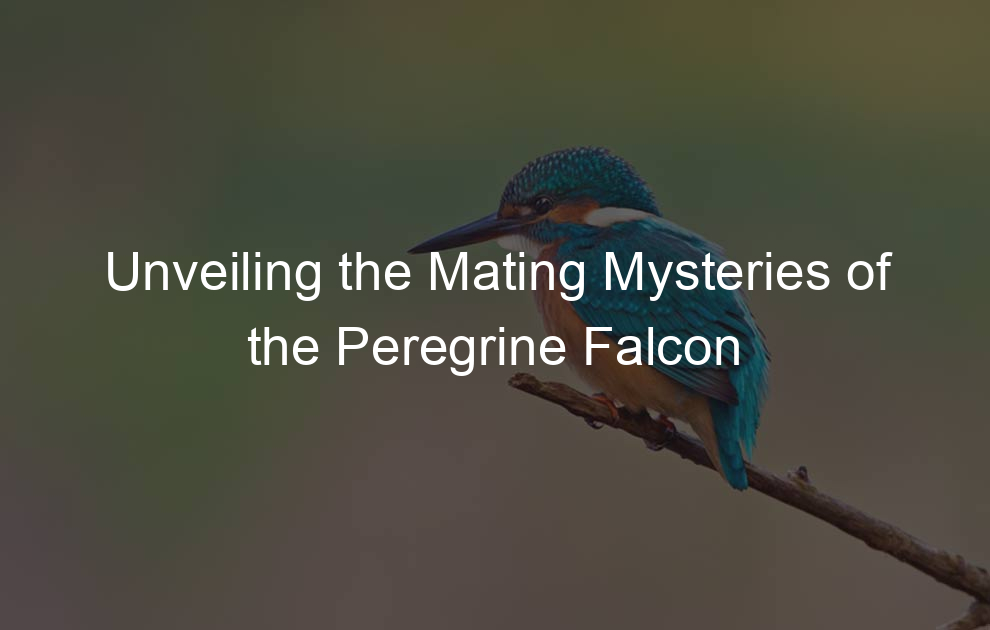Introduction to Peregrine Falcon Breeding
Hey bird enthusiasts! Today, we’re going to dive into the fascinating world of Peregrine Falcon breeding. These birds are not just fast flyers; they have some really cool breeding habits too. So, let’s get started!
- Overview of Peregrine Falcon breeding
- Importance of understanding Peregrine Falcon mating habits
The Peregrine Falcon, also known as the ‘wandering falcon’, is a bird that’s known for its speed. But did you know that their breeding habits are just as interesting? These birds usually mate for life, and their breeding season starts in the spring. The female lays about 3-4 eggs, and both parents take turns incubating them for about a month. Once the chicks hatch, they stay in the nest for about six weeks before they’re ready to fly on their own. Pretty cool, right?
Understanding the Peregrine Falcon’s mating habits is not just interesting; it’s also important for their conservation. By knowing when and where these birds breed, we can help protect their nests and ensure the survival of this amazing species. Plus, it’s just really cool to learn about! So, next time you see a Peregrine Falcon, remember, there’s a lot more to these birds than meets the eye.
Stay tuned for our next section where we’ll dive deeper into the Peregrine Falcon’s mating habits. You won’t want to miss it!
Peregrine Falcon Mating Habits
Let’s dive into the fascinating world of Peregrine Falcon mating habits!
Pre-Mating Behavior
- Display of courtship rituals: Peregrine Falcons perform impressive aerial acrobatics to attract a mate. This includes high-speed chases and mid-air flips!
- Role of vocalizations in Peregrine Falcon mating habits: These birds use a variety of calls and sounds to communicate with potential mates, signaling readiness to mate and strengthening their pair bond.
- Initial approach and acceptance: The male falcon approaches the female with food and special calls. If she accepts, it’s a sign that mating can begin.
- Physical act of mating: Mating usually takes place on a high ledge, with the pair often returning to the same spot year after year.
- Post-mating behavior: After mating, the pair stays together to raise their chicks. They share duties like incubating the eggs and hunting for food.
- Timing of the breeding season: Peregrine Falcons usually breed between March and May, but this can vary depending on the location and climate.
- Factors influencing the breeding season: Weather, food availability, and habitat can all impact when Peregrine Falcons start breeding.
- Selection of nesting site: These birds prefer high cliffs, tall buildings, or other elevated spots for their nests.
- Preparation of the nest: Peregrine Falcons don’t build traditional nests. Instead, they scrape a shallow depression in gravel or soil to lay their eggs.
- Role of the nest in Peregrine Falcon reproduction: The nest provides a safe place for the eggs and chicks, protecting them from predators and harsh weather.
- Incubation of Peregrine Falcon eggs: Both parents share incubation duties, keeping the eggs warm for about a month until they hatch.
- Growth and development of chicks: Chicks grow quickly, learning to fly and hunt within a few months of hatching.
- Transition to independence: Young Peregrine Falcons leave their parents’ territory to find their own home range, usually within a year of hatching.
- Longevity and survival rates: Peregrine Falcons can live up to 15 years in the wild. However, many chicks don’t survive their first year due to threats like predators and habitat loss.
- Role in the ecosystem: As top predators, Peregrine Falcons help control populations of smaller birds and rodents, contributing to a balanced ecosystem.
- Urban vs. wild habitats: These adaptable birds can thrive in both cityscapes and wilderness, as long as there’s enough food and suitable nesting sites.
- Impact on breeding habits: Habitat can influence breeding habits. For example, in cities, Peregrine Falcons may breed earlier due to warmer temperatures and abundant food.
- Threats to Peregrine Falcon habitat: Habitat loss, pollution, and climate change are major threats to Peregrine Falcon populations.
- Efforts to preserve and restore habitats: Conservation efforts are underway to protect and restore Peregrine Falcon habitats, including nest site protection and reintroduction programs.
- Summary of key points: Peregrine Falcons have unique mating habits, with impressive courtship displays, shared parenting duties, and adaptability to various habitats.
- Importance of continued research: Continued research is crucial to understand and protect these magnificent birds, ensuring they continue to soar in our skies for generations to come.






